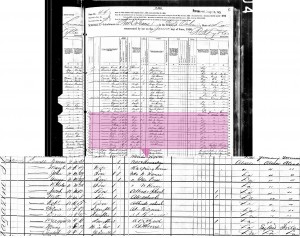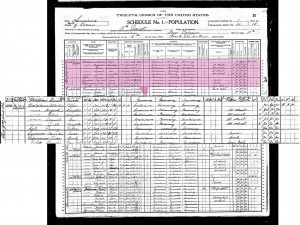In which we do genealogical research and learn that people married their neighbors.
Quite some time passed with us blithely telling people that the house was built in the 1850’s-1860’s, referring to the carriage house out back as “slave quarters” and insisting that the peeling paint we had seen up in the second floor of that carriage house was shaped like a black woman who used to live there in antebellum days. But the thing is we weren’t really sure…
No matter when it was built, it is clear to everyone that it is old. Pre-1900 Victorian. Back when insulation was not something they did and we can stand in the kitchen and see daylight between the boards under our feet because apparently you just used to lay down some boards and voila, you have a floor. I don’t know why this particular detail beyond all other architectural details seemed the most alien to me and the most indicative of another era, but it does. I’m not used to seeing the ground below my feet, as if I’m camping when I’m inside.
We finally decided to get to the bottom of this and started doing some more research. We knew that Herman Levy had sold it to Harry Grimm in 1912 so we needed to know – did Levy buy it? When? Had it been in his family for generations or did he build it?
As David often does, he first consulted the court history and sure enough, there was a lawsuit on the books from 1899/1900. It’s amazing how often when you’re looking for details about someone in the past, it turns out they’ve been party to a legal action, and thus they are recorded for posterity.
Because it is the age of miracles, he pulled up the full court documents from the turn of the last century on his iPhone while we sat on our wide new front porch watching the traffic go by, and we read the convoluted, stilted language, which described for the most part that no one could find Mr. Herman Levy in 1899 despite having attempted to serve him at various addresses on Magazine Street (all within a 1 block radius of our house but none at our address) and finally the court was informed that Mr. Levy was out of the country in Europe.
In question in the suit was an unnamed property (which we initially assumed might be ours) which he had inherited from his grandfather who built it but a cousin Ella now claimed some right to it.
We went inside to the computer and by the dim light of the only electrified sconces in the dining room, and using our brand new internet, we sat there for hours tracing back the history of the Levy family and the other families in the neighborhood, occasionally running outside to check an address or see if a house was still there. Dusk fell and the house grew dark, and we had learned that Herman Levy had married into the Simon family in the green house across the street, they had lived in the next block on Magazine and then probably fallen on hard times because they had moved in with her parents (then in their 80s) in the 1920s.
Finally we went home and took up the search on ancestry.com at which point I started searching censuses all the way back to the 1860s. Since those were taken by house number you could (with patience) find an individual house. Here’s the history of the house and it’s occupants:
1900: Moise Waldhorn, 47 (Loan Officer – ie Pawn broker), wife Albertine, 37 and two daughters 14 and 11, son Samuel, 9 mother-in-law Fanny 75, widowed neice Bernadia, 42, Cook Terisa and House Girl Maudie.
1890: Now, the 1890 census was lost to fire. But there are a few alternatives. One is the city directories (yellow pages of the time) in which we found a Moise Waldhorn who kept a shop at 77 Royal St and had an address of 710 Magazine. Given that the addresses had all been renumbered in 1894/1895 ish, we had reason to believe that 710 Magazine might have been the old address for 2502 (back when there were less than 140 houses in the 25 blocks from Canal St. to 1st) so we were fairly sure that Mr. Waldhorn owned it in 1890.
1880: George Powell, 52 (Warehouseman), wife Margaret, 47 (Keeping House) and their 6 sons + 3 daughters ages 29 to 5, daughter-in-law, 23 and granddaughter, 1.
That’s 13 people!!!
(not to mention 5 other children who had died for a total of 14 kids!)
 It was hard to go back further than 1880 with the house itself because 1870 and back the census just numbered the houses as they visited them, they didn’t put addresses on them. But we knew now that we should probably be looking for a sale of the house from George Powell to Moise Waldhorn some time between 1880-1890 and from Moise to Herman Levy some time between 1900-1912.
It was hard to go back further than 1880 with the house itself because 1870 and back the census just numbered the houses as they visited them, they didn’t put addresses on them. But we knew now that we should probably be looking for a sale of the house from George Powell to Moise Waldhorn some time between 1880-1890 and from Moise to Herman Levy some time between 1900-1912.
Time to look elsewhere…

